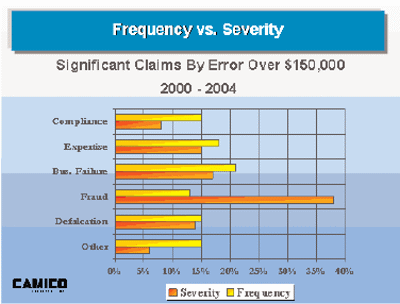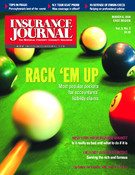Certified public accountants wading into tax season should be aware of heightened exposure to liability as clients make crucial year-end decisions about how to manage tax liabilities for 2005, according to a recent study by Camico Mutual Insurance Company, the nation’s second largest provider of professional liability insurance for CPAs.
Ron Klein, vice president of claims for Camico, says that the technical nature of the tax issues and the financial complexity of business clients can create heightened risk exposures for CPAs who provide tax advice and services for business clients.
More than half of all claims filed against CPAs derive from tax engagements, Klien says. Tax was identified in the study as the most frequent type of claim, generating the largest total of claims dollars incurred, for two reasons: the complex and continually evolving tax codes, and issues regarding the engagement between CPAs and their clients.
“The technical nature of this area of taxation places most of the burden for decision-making on the CPA,” says Klein. “There is usually a limit to how much the CPA can ask the client to decide in technical tax issues. It’s much like a patient seeing a doctor about a serious, complex medical condition; the problem and treatment are so critical that the patient will ultimately go with the treatment the doctor recommends.” The study, conducted in October 2005, included the claims experience of nearly 7,000 firms in 44 states, focusing on the major causes and types of claims incurred by CPAs nationally.


Areas of highest risk
CAMICO’s survey found that taxation, financial statements, investment fraud, and defalcation (embezzlement) were practice areas that held the highest risk for accountants in the area of professional liability claims.
Taxation: In taxation claims, technical income tax issues are the primary area of loss according to the study. In addition, S and C corporation elections are the next most risky, followed by estate planning.
Klein noted that tax professionals must be sure of their competency and ability to render the best advice possible for the client, and he cautioned about the potential for “engagement creep,” in which the scope of work expands significantly beyond the original engagement agreement between the CPA and the client.
“All clients and engagements should be re-evaluated on a regular basis, at least annually, to assure the firm is capable of performing the services required by the engagement and that the firm is practicing the services often enough to be proficient,” Klein says.
Financial statement: In particular, financial statements involving audits, third-party creditors, and occupational fraud are the second highest area of liability risk. Financial statement fraud has long been the leader in “severity” of claims–the greatest financial loss per incident–notes Klein. “The basic issue with financial statements for third-party creditors is that the client pays for the work, but the work benefits the creditor, placing the client’s interests and those of the creditor at odds with each other.”
Clients are often inclined to pressure the CPA to create statements that satisfy the bank, and as the process becomes more routine, the CPA becomes complacent and loses the skepticism necessary for a competent review or audit, Klein advises.
“A typical area of trouble is in the valuation of inventory or assets, where the CPA goes along with the client on how valuation is determined, which then results in a possible significant material misstatement,” Klein says. “The lender is left with an inaccurate view of the client’s business, and the CPA is exposed to liability for the misstatement, especially if the business fails.”
Investment Fraud: The third most frequent and/or severe area of claims involves investment fraud, which strikes in large dollar amounts and includes accounting services such as reviews, audits, tax and investment advice. When it comes to investment advisory services, CPAs fall into trouble because they fail to perform adequate due diligence in determining the potential for investment fraud before any work is performed.
“This is fundamental to engagement practice,” Klein says. “Obtaining background, credit and reference checks for the client and paying attention to client integrity and competency, or lack thereof, is essential if a CPA is going to make any investments on a client’s behalf or if giving advice.”
Defalcation: Another area causing high losses is embezzlement by client employees, or occupational fraud, which costs U.S. businesses more than $6 billion each year. Defalcation involves a variety of engagement types including all accounting services ranging from bank reconciliation services to audits as well as tax engagements.
Even so-called “low-level” engagements such as write-up, bookkeeping and bank reconciliations are plagued by this problem, exacerbated by client and public expectations of CPAs to always detect fraud and to advise and warn clients about potential fraud. Such expectations have increased dramatically since the accounting scandals in the early part of this decade.
CPAs cannot possibly detect all fraud, but they can focus on the advice and warning aspects of engagements.
“The expectation to advise and warn is much less difficult than actual detection of fraud and is the heart of where the CPA can prevent losses to his or her practice,” Klein said. “By carefully noting areas of exposure to loss and putting clients on documented notice about those areas, CPAs can reduce their own liability exposure stemming from unrealistic public and jury expectations.”
Skepticism is key
In all of the areas of exposure to claims liability, a basic remedy is professional skepticism, according to Klein. “Exercising skepticism goes hand-in-hand with the CPA’s ability to detect fraud and to advise and warn clients of weaknesses in their systems of financial control,” he says. “There is no absolute assurance that fraud has not been concealed from the CPA or the client, and this leaves both vulnerable unless the CPA exercises skepticism and the client exercises good judgment and control.”
CPAs can do much to improve the ability of clients to protect their wealth and businesses, such as offering additional services to assist clients in understanding their responsibility to prevent and detect fraud with adequate internal controls. CPAs can also do more to “convince clients that spending a little more up front to provide those controls will be financially justified in the mid to long term,” Klein says. For their part, CPAs need to “be careful to limit the scope of their engagements to closely match their competency and skills to the client and the engagement and to be thinking constantly about client fit and fitness as part of their standard operating style.”
There are a number of fundamental steps the CPA can take to mitigate the risks associated with tax work, Klien says, including loss control techniques such as screening, paying special attention to high risk clients, and clearly understanding their ability to offer advice is especially in tax engagements.
Careful screening of the firm’s clients and engagements will help to avoid “engagement creep,” whereby the scope of an engagement may begin to extend beyond the competencies of the CPA firm. All clients and engagements should be re-evaluated on a regular basis, at least annually, to assure the firm is: capable of performing the services required by the engagement; and is performing the services frequently enough to become proficient at them.
Also, some clients are much more risky than others. The risky clients can be identified by: running credit checks, examining previous financial statements, examining the client’s prior accounting firm’s management letters, and interviewing the client, the client’s key personnel, bankers, legal counsel, prior accountants and auditors.
“The tax professional must be sure of his or her competency and ability to render the best advice possible for the client,” says Klein. “In the realm of income taxation, the CPA’s job is to advise and warn the client about alternatives and their possible benefits and risks,” Klein adds.
Was this article valuable?
Here are more articles you may enjoy.


 JPMorgan Client Who Lost $50 Million Fortune Faces Court Setback
JPMorgan Client Who Lost $50 Million Fortune Faces Court Setback  North Carolina Adjuster and Son Charged With Embezzlement in Roof Jobs
North Carolina Adjuster and Son Charged With Embezzlement in Roof Jobs  Carnival Puts Miami Headquarters Up for Sale as Florida Real Estate Soars
Carnival Puts Miami Headquarters Up for Sale as Florida Real Estate Soars  Former MLB Player, 3 Others Charged with Staging Auto Accident in Miami
Former MLB Player, 3 Others Charged with Staging Auto Accident in Miami 


